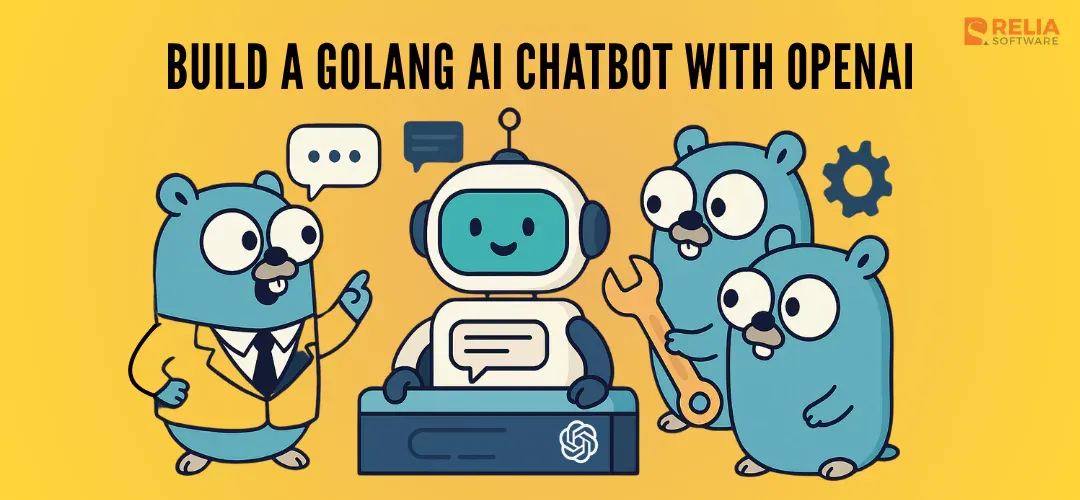AI chatbots are increasingly in high demand, from customer support to personal assistants and internal automation tools. If you're looking for a fast, efficient language to build one, Golang is a strong choice.
In this guide, we'll show you how to create an AI chatbot using Go and OpenAI. These chatbots use large language models (LLMs) such as GPT-3.5, GPT-4, and the latest o1 models to understand user inputs and generate human-like responses. Combining Go's efficiency and OpenAI's AI capabilities makes this approach particularly suitable for high-performance applications requiring real-time interactions.
>> Read more:
Why Use Go for AI Chatbot Development?
Go offers several advantages for chatbot development, including excellent concurrency support through goroutines, fast compilation times, and built-in networking capabilities.
The language's simplicity and performance characteristics make it ideal for handling multiple concurrent chat sessions while maintaining low latency. Additionally, Go's strong typing system and comprehensive standard library provide a solid foundation for building secure, maintainable chatbot applications.
OpenAI Libraries Setup
The most widely adopted library for OpenAI integration in Go is github.com/sashabaranov/go-openai. This unofficial but comprehensive library provides support for ChatGPT 4o, o1, GPT-3, GPT-4, DALL·E, and Whisper APIs. The library offers clean interfaces for chat completions, streaming responses, and advanced features like function calling and structured outputs.
For official support, OpenAI provides github.com/openai/openai-go, which is the official Go library for the OpenAI API. This library includes comprehensive examples for chat completions, streaming responses, tool calling, and structured outputs.
To begin development, initialize a Go module and install the required dependencies:
go mod init your-chatbot-project
go get github.com/sashabaranov/go-openaiFor projects requiring additional functionality, consider these added libraries:
github.com/gorilla/websocketfor real-time communicationgithub.com/spf13/cobrafor command-line interfacesgithub.com/langchain-go/langchain-gofor advanced LLM workflows
Core Implementation Patterns
Basic Chat Completion
The fundamental pattern for implementing a chatbot involves creating an OpenAI client and making chat completion requests. Here's the essential structure:
package main
import (
"context"
"fmt"
openai "github.com/sashabaranov/go-openai"
)
func main() {
client := openai.NewClient("your-api-key")
resp, err := client.CreateChatCompletion(
context.Background(),
openai.ChatCompletionRequest{
Model: openai.GPT3Dot5Turbo,
Messages: []openai.ChatCompletionMessage{
{
Role: openai.ChatMessageRoleUser,
Content: "Hello!",
},
},
},
)
if err != nil {
fmt.Printf("ChatCompletion error: %v\\n", err)
return
}
fmt.Println(resp.Choices.Message.Content)
}Conversation Context Management
Maintaining conversation context is crucial for creating coherent chatbot interactions. The implementation requires storing and managing message history throughout the conversation session:
type ChatSession struct {
Messages []openai.ChatCompletionMessage
Client *openai.Client
}
func (cs *ChatSession) AddMessage(role, content string) {
cs.Messages = append(cs.Messages, openai.ChatCompletionMessage{
Role: role,
Content: content,
})
}This approach ensures that each API call includes the complete conversation history, enabling the AI to provide contextually relevant responses.
Streaming Responses
For enhanced user experience, implementing streaming responses allows the chatbot to display partial responses as they're generated. The streaming implementation reduces perceived latency and provides real-time feedback:
stream, err := client.CreateChatCompletionStream(ctx, req)
if err != nil {
return err
}
defer stream.Close()
for {
response, err := stream.Recv()
if errors.Is(err, io.EOF) {
break
}
if err != nil {
return err
}
fmt.Print(response.Choices.Delta.Content)
}Authentication and Security
API Key Management
Secure API key handling is fundamental to chatbot security. Best practices include storing API keys as environment variables rather than hardcoding them in source code:
apiKey := os.Getenv("OPENAI_API_KEY")
if apiKey == "" {
log.Fatal("OPENAI_API_KEY environment variable is required")
}
client := openai.NewClient(apiKey)>> Explore: API Development in Go with OpenAPI: A Comprehensive Guide
Additional Security Considerations
Implement input validation and sanitization to prevent malicious inputs from compromising the system. Use secure communication protocols (HTTPS) and consider implementing rate limiting to protect against abuse. For production environments, establish proper logging and monitoring to track API usage and detect anomalies.
Error Handling and Recovery
Common Error Types
Effective error handling is essential for robust chatbot implementations. Common error scenarios include API rate limits, network timeouts, and invalid requests. The go-openai library provides structured error types for different scenarios:
if err != nil {
var apiErr *openai.APIError
if errors.As(err, &apiErr) {
switch apiErr.HTTPStatusCode {
case 401:
// Invalid authentication
case 429:
// Rate limit exceeded
case 500:
// Server error
}
}
}Graceful Degradation Strategies
Implement fallback mechanisms to maintain service availability when primary systems fail. This includes using alternative models, cached responses, or human handoff when AI services are unavailable. Maintain conversation context and provide clear error messages to users while preserving their session state.
Rate Limiting and Performance Optimization
Rate Limiting Implementation
OpenAI enforces rate limits on API requests, making proper rate limiting essential for production applications. Implement token bucket or sliding window algorithms to manage request rates:
import "golang.org/x/time/rate"
limiter := rate.NewLimiter(rate.Every(time.Second), 10) // 10 requests per second
func makeAPICall(ctx context.Context) error {
if err := limiter.Wait(ctx); err != nil {
return err
}
// Proceed with API call
}Performance Best Practices
Optimize performance through strategic use of context timeouts, connection pooling, and request batching where appropriate. Consider implementing caching for frequently requested information and use appropriate model selection based on use case requirements. Monitor token usage to manage costs effectively while maintaining response quality.
Context and Timeout Management
Context Usage
Proper context management ensures responsive applications and prevents resource leaks. Implement context timeouts for API calls to handle network issues gracefully:
ctx, cancel := context.WithTimeout(context.Background(), 30*time.Second)
defer cancel()
resp, err := client.CreateChatCompletion(ctx, request)For streaming responses, implement separate timeouts for connection establishment and response reading. This prevents applications from hanging indefinitely when network conditions are poor. Consider implementing retry logic with exponential backoff for transient failures.
Project Structure and Architecture
Recommended Project Layout
Structure your chatbot project following Go conventions for maintainability and scalability:
chatbot-project/
├── cmd/
│ └── chatbot/
│ └── main.go
├── internal/
│ ├── chatbot/
│ │ ├── service.go
│ │ └── handler.go
│ ├── openai/
│ │ └── client.go
│ └── config/
│ └── config.go
├── pkg/
│ └── models/
├── web/
│ └── static/
└── go.modInterface Design
Design clean interfaces for testability and modularity. Separate concerns by creating dedicated packages for different functionalities:
type ChatService interface {
ProcessMessage(ctx context.Context, userID, message string) (string, error)
GetConversationHistory(userID string) ([]Message, error)
}
type OpenAIClient interface {
CreateChatCompletion(ctx context.Context, req ChatCompletionRequest) (*ChatCompletionResponse, error)
}Testing and Mocking
Unit Testing Strategies
Implement comprehensive testing using Go's built-in testing framework combined with mocking libraries. Use dependency injection to make components testable:
func TestChatService_ProcessMessage(t *testing.T) {
mockClient := &MockOpenAIClient{}
service := NewChatService(mockClient)
mockClient.On("CreateChatCompletion", mock.Anything, mock.Anything).
Return(&ChatCompletionResponse{
Choices: []Choice{{Message: Message{Content: "Test response"}}},
}, nil)
response, err := service.ProcessMessage(context.Background(), "user1", "Hello")
assert.NoError(t, err)
assert.Equal(t, "Test response", response)
}Mock Implementation
Use libraries like github.com/stretchr/testify/mock or github.com/vektra/mockery to generate mocks for OpenAI client interfaces. This enables testing without making actual API calls.
Deployment and Production Considerations
Deployment Strategies
Deploy chatbots using containerization with Docker for consistency across environments. Consider using orchestration platforms like Kubernetes for scalability and resilience. Implement health checks and graceful shutdown mechanisms:
func (s *Server) Shutdown(ctx context.Context) error {
return s.httpServer.Shutdown(ctx)
}>> Read more:
- A Practical Guide to Kubernetes ConfigMaps for App Configuration
- A Comprehensive Guide To Dockerize A Golang Application
Environment Management
Maintain separate configurations for development, staging, and production environments. Use environment-specific API keys and rate limits. Implement configuration management through environment variables or configuration files.
Monitoring and Observability
Establish comprehensive monitoring for API usage, response times, error rates, and token consumption. Implement structured logging and consider using distributed tracing for complex systems. Monitor costs closely as OpenAI charges per token usage.
Advanced Features and Integration
Function Calling and Tool Integration
Modern chatbots can leverage OpenAI's function calling capabilities to integrate with external systems. Define function schemas using JSON Schema format:
functions := []openai.FunctionDefinition{
{
Name: "get_weather",
Description: "Get current weather for a location",
Parameters: jsonschema.Definition{
Type: jsonschema.Object,
Properties: map[string]jsonschema.Definition{
"location": {
Type: jsonschema.String,
Description: "City and state",
},
},
Required: []string{"location"},
},
},
}Structured Outputs
Implement structured outputs for consistent response formats. This feature ensures chatbots return data in predefined schemas, improving reliability for downstream processing.
WebSocket Integration
For real-time applications, integrate WebSocket support for instant message delivery. This enables responsive user experiences similar to modern chat applications.
enables responsive user experiences similar to modern chat applications.
Current Standards and Best Practices
API Version Management
Stay current with OpenAI's API versions and model updates. The latest recommended models include GPT-4o for general purposes and o1 models for complex reasoning tasks. Monitor OpenAI's documentation for deprecation notices and migration guides.
Compliance and Ethics
Implement content filtering and safety measures according to OpenAI's usage policies. Consider implementing user consent mechanisms and data privacy protections. Follow responsible AI practices including bias detection and mitigation.
Performance Monitoring
Establish key performance indicators (KPIs) including response time, accuracy, user satisfaction, and cost per interaction. Regularly evaluate model performance and consider fine-tuning for specific use cases.
Conclusion
Building Golang AI chatbots with OpenAI represents a powerful combination of technologies for creating sophisticated conversational applications. Success requires careful attention to architecture design, security implementation, performance optimization, and ongoing maintenance.
By following the patterns and practices outlined in this documentation, developers can create robust, scalable chatbot solutions that meet both technical and business requirements. Regular updates and monitoring ensure continued effectiveness as both Go and OpenAI technologies continue to evolve.
The ecosystem continues to grow with new tools, libraries, and best practices. Staying informed about developments in both the Go community and OpenAI's platform ensures that implementations remain current and effective. Future developments in areas like multimodal capabilities and improved reasoning models will further expand the possibilities for Golang-based AI chatbot applications.
Practical Implementation Resources:
For developers looking to implement these concepts in practice, the repository at https://github.com/cesc1802/golang-ai-chatbot provides a complete example of building AI chatbots using Go and OpenAI's API. Hope my sharings will help your journey in building Golang AI chatbot.
>>> Follow and Contact Relia Software for more information!
- golang
- coding
- development

